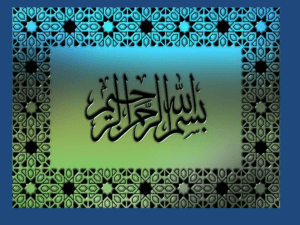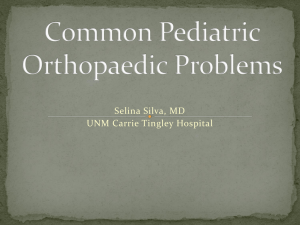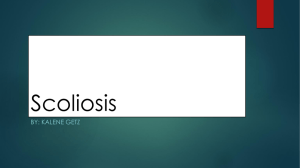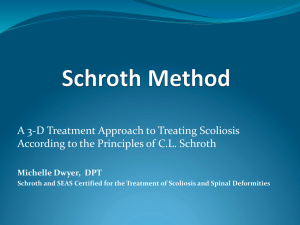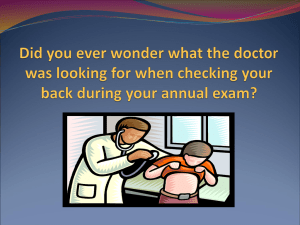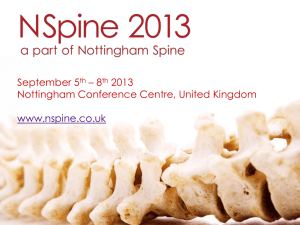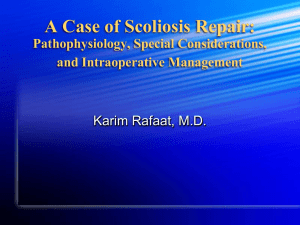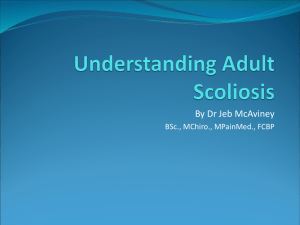Document
advertisement
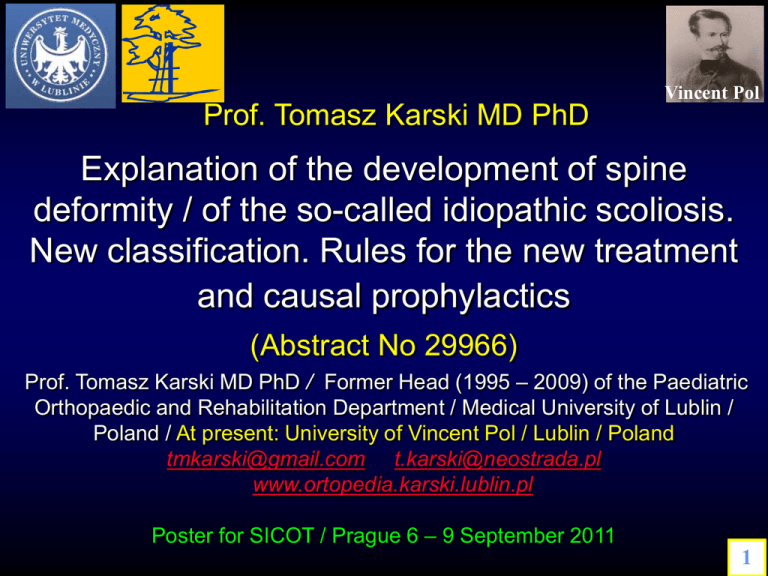
Vincent Pol Prof. Tomasz Karski MD PhD Explanation of the development of spine deformity / of the so-called idiopathic scoliosis. New classification. Rules for the new treatment and causal prophylactics (Abstract No 29966) Prof. Tomasz Karski MD PhD / Former Head (1995 – 2009) of the Paediatric Orthopaedic and Rehabilitation Department / Medical University of Lublin / Poland / At present: University of Vincent Pol / Lublin / Poland tmkarski@gmail.com t.karski@neostrada.pl www.ortopedia.karski.lublin.pl Poster for SICOT / Prague 6 – 9 September 2011 1 INTRODUCTION / IDIOPATHIC SCOLIOSIS: (1) aetiology unclear till 1995 (2) „Biomechanical influence” connected with asymmetry of movements in hips found in 1995 (T. Karski) (3) Hips movement asymmetry connected with „Syndrome of contractures” (Prof. Hans Mau) / (4) Development of spine deformity through „gait” and „standing” on right leg (T. Karski 1995 - 2007) Material 1995 – 2007 (N) 1450 cases. New classification: patients were divided into (3) three groups and (4) four types (2006): „S” scoliosis I-epg / 3D / two curves / stiff spine / progression / some cases - lordoscoliosis. Causes: „gait” & „standing”, „C” scoliosis II/A-epg / 1D / one curve / flexible spine / no progression / Causes: „standing”, „S” scoliosis II/B-epg / 2D / two curves / thoracic curve – secondary / flexible spine / no or small progression / some cases - kiphoscoliosis / Causes: „standing”, additionally for „S” scoliosis laxity of joints and wrong exercises, „I” scoliosis III-epg / 2D / no curves or small / stiff spine / no progression / children – problem with sport, adults – pain. 2 Causes: „gait”. [explanation: epg – etiopathological group] Model of hip movements and type of scoliosis (2006) Left hip adduction/x Right hip adduction/x I II Aetiology of scoliosis & New classification (T. Karski 1995/2001-2004) Examination of adduction of hips. Type of scoliosis: „S”I-epg, „C”-II/A-epg, ”S”-II/B-epg, ”I”-III-epg and ... 45causative influences connected with gait and standing 50 left hip 40 35 30 right hip Important difference in range of adduction 25 III 20 I-epg II II-epg A/B standing „S” 1D / 2D standing III-epg O - 5 III I 10 x/Degree of adduction – examination- in straight position of hip joint. Abbreviation: epg = etiopathogenetical group of scoliosis gait & standing „C” 1D 15 10 „S” I-epg – some cases are „lordoscoliosis” „S” II/B-epg – some cases are „kifoscoliosis” 5 „S” 3D „I” 2D gait 3 4 50 40 50 40 30 20 0 (-)5 right (-)10 left – hip adduction in degrees Model of hips movements in „S” scoliosis I epg Influence: „standing” and „gait” 30 20 0 (-)5 (-)10 left – right hip adduction in degrees left – right hip adduction in degrees Model of hips movements in „C” scoliosis II/A epg and in „S” scoliosis II/B epg Model of hips movements in „I” scoliosis III epg Influence: „standing” Influence: „gait” New Classification. Biomechanical influences on „gait” & ‘standing position’ in aetiology. Specific model of hips movements in 3 groups and 4 types of scoliosis. 4 Treatment / Prophylaxis Therapy: Bending - forward Bending to the left Bending to the right Many times per day ! Proper therapy of scoliosis (Marysia K. No 940121): *Removing of contracture of right hip (stretching) / *Removing of contractures of both curves (L&Th) *Active sport – Karate. / *Sleeping in embryo position. / *Standing on the left leg „S” I epg scoliosis. Result of proper (new) therapy / 2004 - 2008. 5 20o 4o 22o 19.05.2004 17.08.2005 19.10.2006 24.05.2008 Discussion & Conclusions 6 • (1) The aetiology of the so-called idiopathic scoliosis is strictly biomechanical. Every type of scoliosis starts with the development when the child starts to „stand” and starts to „walk”. Every child with scoliosis has the habit of standing ‘at ease’ only on the right leg. • (2) Scoliosis is a secondary deformity connected with function: „gait” and „standing”. The „infantile scoliosis” is not „idiopathic scoliosis”. • (3) The contracture (in abduction, often in external rotation & flexion) of the right hip is connected with the „ Syndrome of Seven Contractures” [„Siebener [Kontrakturen] Syndrom” – Prof. Hans Mau / Germany /. • • (4) The abduction contracture or restricted adduction of the right hip is the cause of „oblique position of pelvis” (X-ray of hips in infants). Signal for spine in future. • (5) Every type of scoliosis („S” I epg, „C” II/A epg, „S” II/B epg and „I” III epg) is connected with adequate „model of hip movements” [T. Karski, 2006]. • (6) In causal prophylaxis of scoliosis all stretching exercises protecting against the „stiffness of spine” are very effective as well as those removing contractures of the right hip and both hips. All „far east stretching sports” (karate) are especially useful. Literature & discussion on www.ortopedia.karski.lublin.pl Discussion & Conclusions New classification - „S” double scoliosis connected with „gait” and standing ‘at ease’ only on the right leg (7) I epg - "S" primary double scoliosis (2001). Stiffness of spine. Gibbous - rib prominence. Beginning in age 2-3 years. Abduction contracture of right hip 5 - 10 degree or adduction 0 degree. Very often external rotation contracture and flexion contracture of the right hip. Left hip adduction 40 - 45 - 50 degree (model of hips movement decide about type of scoliosis – 2006 – T. Karski). Mechanical influence - gait and standing permanent "at ease" on right leg. Progression. Some cases "lordoscoliosis". Risser test important. 7 Discussion & Conclusions New classification - „C” one curve scoliosis connected only with standing ‘at ease’ on the right leg (8) II/A epg - "C" one curve scoliosis (L sin, or L+Th sin or L+S sin) – 2001 /2006. No stiffness of spine. No and never gibbous - rib prominence. Beginning in age 2-3 years but scoliosis is to see in age 10 - 13 years. No abduction contracture of right hip but only smaller adduction (20 - 30 – 35 / degree) in comparison to left hip with adduction 40 - 45 50 degree (model of hips movement decide about type of scoliosis – 2006 – T. Karski). Mechanical influence - only standing permanent "at ease" on right leg. No progression. Risser test not important. This type of scoliosis is diagnosed in old people as "degenerative scoliosis". 8 Discussion & Conclusions 9 New classification - „S” double curve scoliosis connected with standing ‘at ease’ on the right leg, with general laxity of joints and often with harmful / wrong exercises (9) II/B epg - "S" two curve scoliosis - but thoracic curve is secondary - 2001/2006. No stiffness of spine. Gibbous - rib prominence - small, round. Beginning in age 2-3 years. But scoliosis is to see in age 8 - 11 years. No abduction contracture of right hip but only smaller adduction 20 - 30 – 35 degree in comparison to left hip where the adduction is 40 - 45 - 50 degree (model of hips movement decide about type of scoliosis – 2006 – T. Karski). Mechanical influence - only standing permanent "at ease" on right leg. Secondary influences - laxity of joints and extension / strengthening bad exercises (wrong / not proper / harmful). No progression or small. Some cases "kyphoscoliosis / kifoscoliosis". Risser test not special important. Discussion & Conclusions 10 New classification - „I” scoliosis without curves or small, without gibbous or small / unimportant. Connection with „gait” but not with standing (10) III epg - "I" scoliosis - "scoliosis without scoliosis” /without curves/ - 2004. Large stiffness of spine. Gibbous (rib prominence) no - or very small, not important clinically. Curves no - or small, not important clinically. Beginning in age 2-3 years. Abduction contracture 5 - 10 degree of right hip or adduction 0 degree. Left hip adduction also small 20 - 25 degree (model of hips movement decide about type of scoliosis – 2006 – T. Karski). Mechanical influence - only gait. No progression. Risser test not important. About the problem know the patients / the people / very late - in age of 20 - 25 - 30 years - because of pain. Sometimes in age of 10 - 20 years they notice sport problems (stiffness) and they do not know why they "have sport problems" and in school bad notes. Letter & Confirmation 11 (letter - 9th September 2011) Dear Prof. Dr Tomasz KARSKI, „ ... With a record number of more than 3,000 participants from 100 countries, the SICOT 2011 XXV Triennial World Congress held in Prague was very successful and we would like to thank you for your active participation. Your presentation contributed to the high scientific level of the congress which covered all aspects of today’s most advanced orthopaedic treatments …” Further to your presentation during the Congress, please find attached a certificate of presentation for your abstract, 29966, entitled "Explanation of development of spine deformity. New classification. Rules of new treatment and causal prophylactics". Best regards, On behalf of SICOT President Prof. Maurice Hinsenkamp The SICOT Congress Secretariat Letter & Confirmation 12 Letter - 9th September 2011: Dear Prof. Dr Tomasz KARSKI / „ ... Your presentation contributed to the high scientific level of the congress which covered all aspects of today’s most advanced orthopaedic treatments …” / Best regards, On behalf of SICOT President Prof. Maurice Hinsenkamp / The SICOT Congress Secretariat
